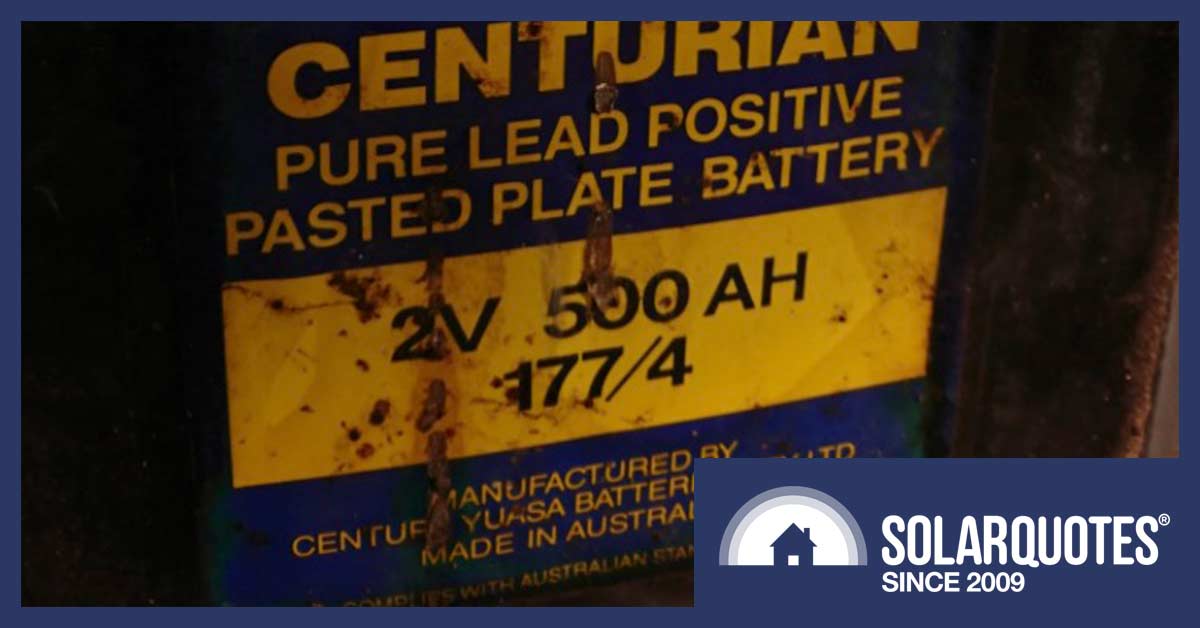
We live in an age where your camper trailer can power an induction cooktop, a mine can go off-grid, and giant grid-scale batteries are being announced almost weekly.
These developments in mobile, remote area and utility-scale energy storage would be impractical or impossible with lead-acid batteries. The performance of lithium-ion batteries has eclipsed the 100-year-old lead-acid technology.
Many industry folks will tell you “lead is dead”. But like any well-proven technology, people trust it, and warrant it. In some applications, like an electric forklift, the weight is actually handy.
Why Lithium-Ion Batteries Usually Win
- Smaller size and higher energy density mean you can store more energy in less space.
- Lighter weight means transport, logistics, and handling them is easier.
- The round-trip efficiency is really good. 95% of the energy you put in can be drawn back out.
- While they may still be more expensive upfront, when you consider the cycle life they readily become cheaper because they’re warranted to last longer.
- They can be driven much harder: charged faster, discharged faster and routinely worked to much deeper states of discharge. So for the same nominal kilowatt-hour capacity, you can get more out of a lithium battery. This means you can get away with buying a smaller one in the first place.
Lead-Acid Requires TLC
Lead-acid likes to work in the top 20% of its state of charge. They’ll handle 30 or 40%, but the deeper you discharge the shorter their life is. If you take 60% out of them it’s considered an emergency.
Whereas you can happily run 80% out of a lithium-ion battery and rapidly charge it back up to 100% the next morning with a big solar panel array.
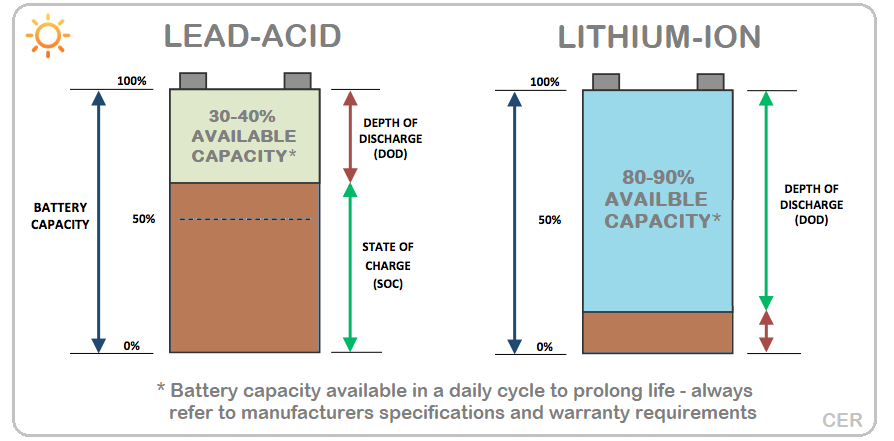
Image credit: Clean Energy Reviews
Conversely, charging lead acid batteries is like steering a ship. You need time to get them headed in the right direction. Thrash about too much and Peukert’s exponent will rob you of great wads of efficiency.
Lead-acid likes to be cared for, with currents kept modest and sustained equalisation charges to balance them up every fortnight. They can reward you with 20 years of life if you do. In fact, I have a set of geriatric flooded cells from a Telstra phone exchange that, despite a few failures, are still bubbling away quietly at 30+ years.
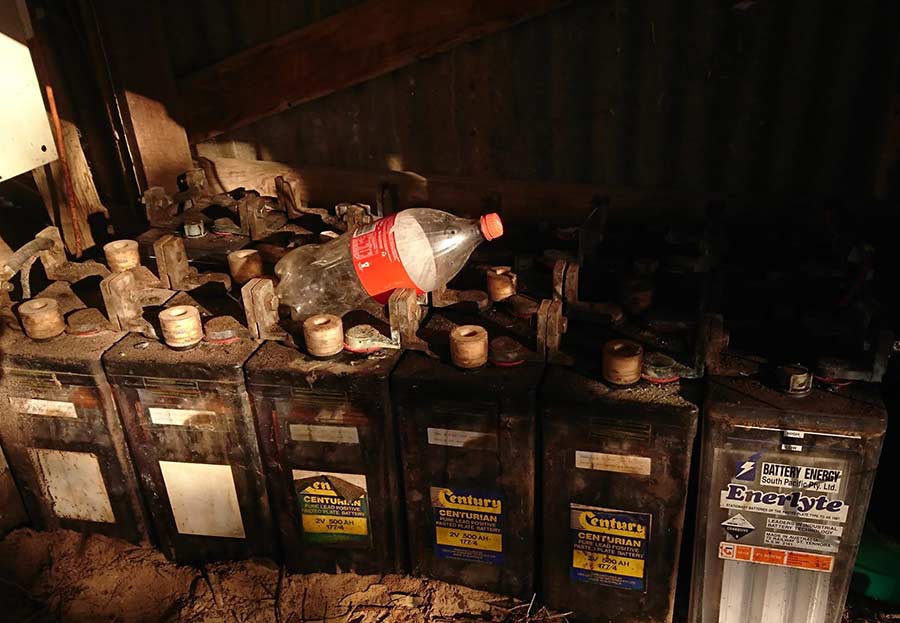
Wherever you find flooded cells, there will be bottles for topping up water.
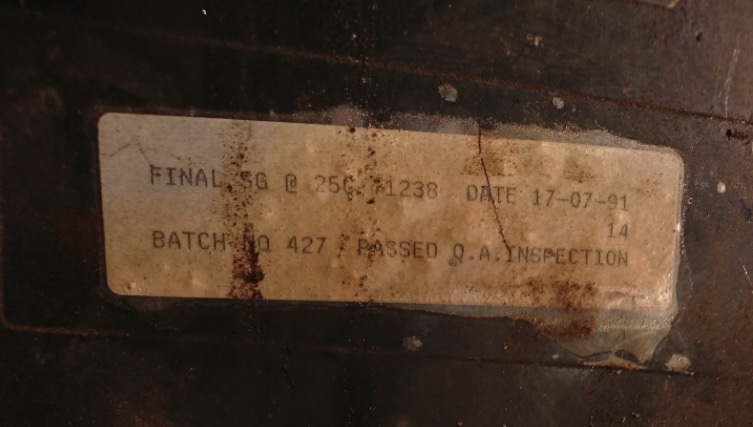
17th July 1991. I’ve never been sure if that’s a manufacturing date or a test done by Telstra for a maintenance program. At 30+ years and their third deployment, there’s still enough to run the fridge over Easter.
Put simply, lead-acid should be cycled in the top 20% of its capacity ideally. A nominal 10 kWh of storage would be happy to provide 2 kWh of stored energy daily. A lithium-ion battery of the same rating would happily return 80% of its capacity, so you could get 8 kWh of storage.
Lithium-Ion Battery Packs Are Easy To Scale
The other incomparable feature of lithium is that they generally come in self-contained slabs of nominal kilowatt-hour capacity. This means you can buy two or three batteries with, say, 3 kWh of storage each. If they prove insufficient over winter or you find your consumption grows, you can just add more batteries later.
Lead acid banks come in whatever size you order, and increasing capacity means either you buy another complete set to double up, or sell them and buy different ones.
In either case, mixing any batteries of considerably different ages isn’t really wise, but lead acid is probably worse affected.
But… Lead Acid Is Not Dead Yet
Aside from being perfectly understood with 100 years of proven history, perhaps the principal advantage lead-acid has is that they’re 100% recyclable. I think everything bar the sticker on the front can be made into a new battery, and we already have all the technology and infrastructure in place to close the loop on production.
The scrap value of lead means people will do the work involved in taking them away for free. My former auto electrical employer found they’ll lift them over a chain mesh fence on the weekend while you’re not watching. Those were hard-working thieves.
And while I don’t like to engage in hyperbole, lead acid doesn’t burst into spectacular self-sustaining incendiaries.
Old flooded lead acid cells can make hydrogen, which is explosive, but they’ve never needed a complex layer of electronics to keep them in a goldilocks zone of temperature and charge. Lead has preferred conditions, but just isn’t as outright fussy.
My gut feeling is lead can have a role in modest stationary applications in the future.
Lithium-ion is great in cars and phones but I think it’s wasteful in, for instance, electric window shutters (cheaper than an electrician installing wiring, ironically).
It was only a couple of years ago I was involved in taking 8 tons of lead to Innaminka to repower the RFDS clinic there. Using lead carbon, a newer and better-performing lead-acid technology, was cheaper; and they’re not going anywhere soon.
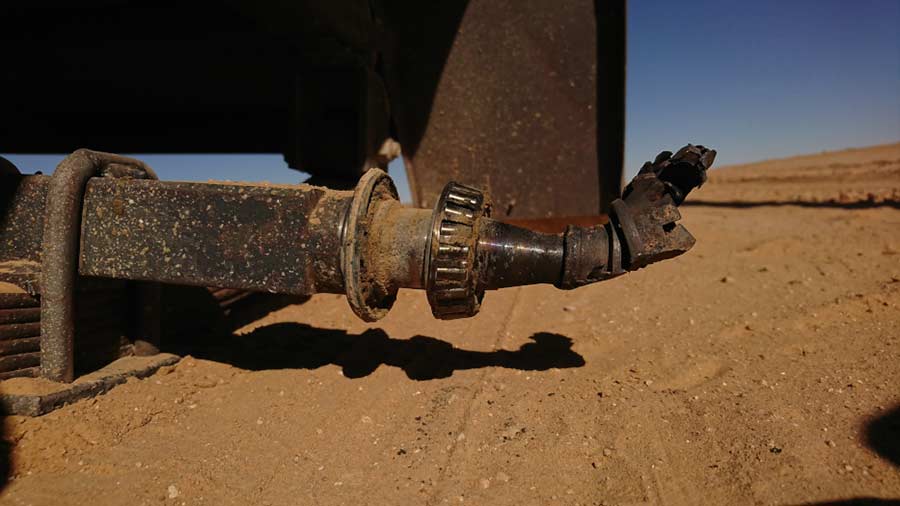
With great power comes the heavy burden of responsibility. Facing a tonne of lead, the trailer wheel bearing couldn’t bear it after 900km.
Lithium EV Batteries Can Get A Second Life
Electric vehicles are really hard on batteries – you really need light weight and high performance to meet people’s ludicrous expectations of what a car should do. As they age and performance degrades, you’ll eventually find your EV doesn’t go as far, as fast, for as long. The troglodytes love to point this out as a failure of electric vehicles without knowing you can already double the range of a 10-year-old Mitsubishi i-Miev with a new battery.
The best part is the old pack has a salvage value, because “low performance” EV batteries are still perfectly viable for less demanding applications such home battery storage or street lights. Nissan and BMW both offer ‘second-life’ lithium-ion batteries as home storage, where the less strenuous charge and discharge cycles mean ageing batteries are less of a problem.
What About Recycling?
The Chinese battery industry and Tesla are pursuing used batteries, because they are high-grade ore to make new batteries.
Lithium batteries often contain high-grade copper and aluminium in addition to – depending on the chemistry – cobalt and nickel, as well as rare earths. Processes are being developed to recover not only cobalt, nickel, copper, and aluminium from spent battery cells, but also a significant share of lithium, graphite and manganese. Recycling processes recover 25% to 96% of the materials of a lithium-ion battery cell, depending on the separation technology.
According to recent reports, China has even been buying used EV batteries from overseas. Bao Wei, the general manager of Jiangsu Huayou, a recycling unit of Zhejiang Huayou Cobalt, said at a forum in Nanjing the now millions of EVs on the roads globally are well described as “moving metal mines.” At least your car battery won’t be as easy to steal as a catalytic converter.
It’s a concept Elon Musk touched on too at a Tesla annual general meeting, saying you can think of batteries as:
“essentially high-grade ore … So you can either get your lithium and your nickel and the various constituents of the battery from rocks, or from batteries. It’s much better to get them from batteries,”
Spending My Own Money
I haven’t settled on what to use at my house yet. Going on the lack of brown paper envelopes I’ve received from solar battery manufacturers1, it could easily be second-hand Sonnenscheins salvaged from a tired old off-grid system.
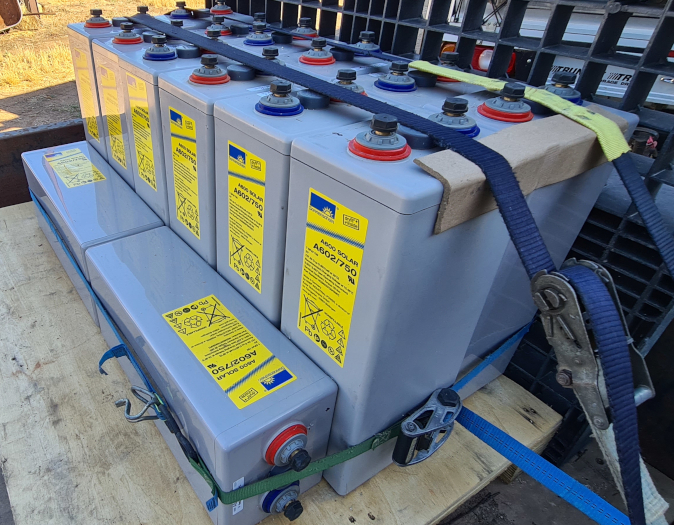
No really, I’ve got a tonne of lead, a hand truck and a masochistic streak.
Footnotes
- Just joking. I won’t even get a discount because the wholesalers know I’m only buying one. ↩

 RSS - Posts
RSS - Posts



There are still some applications for lead acid but they make less and less sense, even for stationary storage. LiFePO4 will happily discharge to 90% and still give you 6000+ cycles. Which means over time it’s actually cheaper. Plus you don’t have to buy a more expensive “off the rack” battery. It’s pretty simple to DIY your own with a BMS and cells. You do need some basic electrical knowledge but there’s also a whole community out there to help.
Lead based batteries are still used in submarines, aircraft and other areas where lithium just isn’t trusted enough. After all a fire on a sub or a plane is pretty much game over.
Anyone these days who uses lead acid in a mobile application (caravan, camper trailer etc) simply hasn’t done their homework.
You’d have to have rocks in your head to choose lead.
SEVEN years ago I tossed out my 240Ah of AGM batteries and replaced them with 400Ah of Winston LFP batteries, assembled into a pack by me.
At the time, the only “smarts” I had were a small individual cell voltage monitor with a configured low/high voltage alarm and a Victron BMV 700 to monitor state of charge by basically counting coulombs in and out.
After a good lengthy original top balance, they only needed additional manual balancing about once every couple of years.
To say they’re cheese and chalk compared to LA is the understatement of the year.
Way over twice the useable capacity (because as you mentioned it’s essential to stay .. at worst, in the top 50% of state of charge with lead and to charge again as soon as possible), a significant weight saving (critical for mobile applications) and much more stable voltage.
I could/would never ever go back to lead acid.
After seven years of typically two to three months or more of full time use per year with our caravan, and almost entirely “off grid” (we don’t normally ever go to places with power), I’ve noticed little if any degradation and reduced capacity. When the weather is good (ie: plenty of solar) we do everything on electricity and often don’t even turn the gas on. If the weather is inclement, then and only then, we use some gas for cooking and hot water, and diesel for heating when required.
It’s just a no brainer!
David,
“No Brainer” is just an irritating term used to make a point.
When you pop the bonnet of your ICE vehicle I can bet you have a lead acid or gel battery looking back at you.
Sure the people at Tesla will sell you a lithium ion setup because they are
lighter and prettier than a lead acid setup. When appearance and weight do not matter but cost does lead acid is the choice used by many in isolated, static situations. People I know had Besser block sheds to house their petrol or diesel generators in days before solar power became efficient. These sheds were out of sight and out of mind and are now filled with
2V lead acid units that I bet will still be operating 20+ years later when
many Li/ion setups have died.
Geoff.
Did you even read my comment Geoff, and just jump in without reading it and digesting it, or just take immediate offence at the phrase “no brainer”?
For clarification I said “IN A MOBILE APPLICATION” & even included “CARAVAN, CAMPER TRAILER etc” (and also effectively included motor homes.)
Also, no matter how much I tried to look after my caravan’s AGM batteries, I never managed to get more than five to six years out of them, and that was almost entirely using just the top 50% of capacity.
Yet you STILL missed the point! I was explaining the benefits of LFP batteries. I would never, ever fit another lead acid battery in a caravan etc ie: a MOBILE APPLICATION.
(Where did I talk about “isolated, static situations” and “besser block sheds”?
And no, thank goodness I actually don’t have a battery under the bonnet in my ICE car at all, the worst place for them. It’s actually AGM, not terribly unlike the batteries I used to have in our caravan, and is under the driver’s seat where it stays nice and cool, is over eight years old and still going very strong. Heat absolutely kills batteries.)
But feel free to do as you please, use whatever battery chemistry you like, and also feel free to take offence and be irritated at the very common phrase “no-brainer”.
All I was doing was apparently wasting my time (as I obviously am now) explaining the benefits of good LFP batteries in caravans, and all other MOBILE applications.
(Also by the way, additionally, I wouldn’t use them in new stationary applications either, but I wasn’t talking about that.)
Bye
David
Have you thought that some caravaners, me included cannot afford to buy a lithium battery and will have to make do with lead acid. We are not all wealthy and are just trying to survive.
I find AGM a waste of money they cannot be serviced like flooded batteries and our lead acid having firstly had 2nd hand 1400 ah lasted another 15 or so years only to be replaced with 2v cells adding to 12v 1600 ah And we are now building again off grid and will definitely be buying flooded lead acid again!
Was told once you can get 10 or more years out of lithium batteries if you lookafter them, my reply was but you can’t look after them you cam only monitor them.
So what your saying is, if you can get lead batteries for free they might be better.
AFAICT, Zinc-Bromine flow batteries outperform both options in this article for stationary (eg. household) use, with daily 100% discharge, fire retardation, ability tp rejuvenate each cell at end of life, large operating temperature band, healthy duscharge rates (eg. 3kW for a 10kWh cell), and more.
Yes, Zn-Br flow batteries win on longevity and thriving on 100% discharge, but their maximum charge/discharge rates are dismal, necessitating a bunch of them in parallel to allow off-grid opportunistic charging between passing cloud systems, and they’re far too expensive to permit that on a realistic budget. That’s why Redflow now markets to telcos instead of us.
It’s also why I think that Anthony has the LFP advantage list in reverse priority order, biggest advantage last. Ability to harvest energy while the sun shines, even if only briefly, is key in an optimised off-grid system. Generously overdimensioned PV, hefty chargers, and a wide-mouthed battery allow a smaller battery. (As Anthony referred to when dismissing narrow mouthed LA.)
My brother has 20 kW of PV, around 15 kW of charging capacity, and wide-mouthed Zenaji LTO batteries. OK, they’re too pricey for me, but he can have them from 10% to 95% before 11 a.m, then export as he remains grid-connected most of the time.
What is beginning to look good to me (for 100% off-grid)) is again 20 kW PV for 6 or 7 kW in winter, 10 kW via MPPTs to a pair of 5 kW Multiplus IIs (for redundancy), and either two 5 kW or one 8 kW Fronius AC coupled inverters on the other 10 kW array to more efficiently drive e.g. the EVSE, a smart one which only uses excess PV energy. Getting excess generation from MPPTs to heavy loads while not exceeding max battery charge rate had long puzzled me. Static charge limits set in the MPPTs won’t adapt to changing AC loads. But Victron’s DVCC mode does. In the absence of better, that floats my boat. Automatically optimising energy management, aided by a smart EVSE, and a HWS diverter responding to the delta-f with which a Victron throttles a Fronius on excess PV production. That there is an open source controller alternative, running a Linux varaint on RPi3B, is a big fat cherry on top. Life/price of LFP may allow a bigger battery than LTO does. Off-grid, that’s gold. P.S. Happy New Year!
Isn’t it true though, that Lithium batteries can easily be discharged overnight due to normal household power requirements – which usually means the bank requires charging as soon as there is sunlight…. hence the spiel about Lithium batteries having the capability to charge back up very quickly – they would need to!
Which makes me wonder how the battery system would cope with a stretch of inclement weather!
I have a lead acid battery set-up which supplies our normal house supply over a full seven days even though they don’t receive any charging at all!
Could the current quality of Lithium batteries match that?
No doubt the installation of a Lithium battery bank has one big advantage over lead acid – weight, but from what I understand the cost of Lithium batteries is still a lot higher than lead acid and only last about half the time.
Surely this would mean you still get a lot more bang for your buck utilizing a lead acid setup even though it might come with a few more maintenance and weight issues.
I quite like having to check water levels in my lead acid batteries periodically…. keeps me in touch with the system and if any problems develop – I can get onto it straight away.
LFP also charges faster so you collect way more energy from your solar than lead. As for not lasting as long, LFP has a proven track record where a decade is easily achievable. I know under the right conditions lead can last almost that long but that means sizing your system to only ever drain less than 30% of it?
That means a very big system when we are talking about enough usable KW for a house for a number of days eg. 20kw for example.
I can get about 20kw of useable lfp storage from China for about 7 or 8 grand that takes up the space of 3 or 4 cartons of beer. Lead would need to take up half of a small bedroom, fine if you have the space, otherwise?
I think lead is now firmly relegated to the realm of starting up gas motors in vehicles now, LFP is the clear choice in my mind.
Oh dear.
It’s pretty obvious that you need to do more study.
A lithium battery bank (any lithium chemistry, though LFP is ideal for storage) rated the same amp hours as lead acid will actually provide more power than lead due less voltage drop under load plus the ability to use close to full cycle capacity without harm to the battery.
Also : the lithium can fully charge much quicker, with no “absorption phase” required.
Also: the lithium will last for far more cycles.
Also: the lithium will not suffer from sulphation and capacity loss if deeply cycled.
Literally the ONLY benefit of lead is cheaper up front cost.
It’s actually dearer per cycle ie: per delivered kWh.
Why hasn’t lfp replaced lead acid for starting gas motors?
My two 12v lead batteries for the truck have died because I don’t drive it very often. The idea of having to replace them every 5 years even if I look after them doesn’t sit well with me when I know how long lfp can last and how much lead batteries cost, $200+ each.
One of the things I haven’t touched on with the article is that lead is still pretty durable when it comes to delivering peak current for a short length of time. ie they’re good for cranking cars. Lithiums all need a BMS to manage them and if you’ve ever used a power tool you’ll notice the performance drops slightly as they deplete the charge, but then they just stop dead. Same too if you just overload the tool. The BMS cries “enough!” and cuts the circuit.
There are lithium cranking batteries available but if you lift the lid you’ll find a supercapacitor inside the box in parallel with the lithium battery. In combination they’re a remarkable device. If you’re having issues with truck batteries I highly recommend getting a supercapacitor. I’ve installed one in a few vehicles and found they extend the useful life of a lead acid cranking battery for years.
Ian,
There is another use for battery storage not covered above.
I use a bank of deep cycle AGM lead acid batteries to power my house during power outages. That includes 2 fridges,
electric kettle, air fryer, a portable air conditioner in summer, 2 gas heater fans in winter plus tv, lights, computers etc.
The bank also includes 2 heavy duty maintenance free deep cycle flooded batteries to provide high starting current for motors.
It won’t run an electric stove though!
The point is that usage is sporadic, not cycled daily. As a result I can discharge the batteries around 80% if necessary, (rare). With a total capacity of 24kWh this would probably power the house for 2 – 3 days.
Through experimenting I have also found the most effective way of recharging the batteries. As noted above this takes up to 3 days which leaves the batteries at peak float voltage ready for the next use.
So, for stand by power AGM’s are cheaper, they are maintenance free, and they can be relied on not to catch fire.
I used to sell batteries for Mobility Scooters and Lead Acid batteries 20 years ago were good value. Getting 4 years out of a set of batteries was a good result for an active user. Along came Gell bateries with a far greater longivity albeit with a substantial price ask.
Alas having a good product is no guarantee of a fair deal as time goes on. Yes good old ‘Built in Obsolesence” is these days battery manufacturers at ever increasing margins is the new normal. Now it is difficult to find a battery manufacturer that has a product that will last the ‘Warranty Period”.
100 years? More like 164 years!
https://en.wikipedia.org/wiki/Lead%E2%80%93acid_battery?wprov=sfti1
Great article though.
Keep an eye on Gridtential. It uses lead and silicon.
I have both lead acid (20 kWh) and LiFePO4 (10 kWh) combined in a hybrid system. The sealed lead acid (ex data centre backup units) is my backup reserve bank kept ready for duty when the inevitable grid outages happen (we get them regularly) while the LiFePO4 does the daily cycling.
Works really well.
We have used LiFePO4, Winston 400 Amp hr, on our small yacht since 2014.
They start the 20hp 3 cylinder diesel perfectly. Don’t know how that compares to starting a petrol engine, but negligible voltage drop, even when bleeding the fuel system (note no decompression facility). Don’t know why they are not used as starting batteries.
With 400Ah of battery you’ve got lots of grunt there.
Even drawing 400A very briefly for starting is just a “1 C” discharge.
Smaller lead acid batteries are often only say 100Ah with similar high, or even higher starting currents, so maybe “4 C” or more starting current.
That’s one of the few things that lead acid are still pretty good at.
Hi Guys
Just wondering if you have any information around Graphene type batteries I read an article saying they had lots of advantages over lithium and were much safer
Thanks
Craig
Hi Craig
Some lithium batteries use graphene, so they are a type of lithium battery rather than something different. (Some call these batteries supercapacitors or ultracapacitors, but I think that’s just likely to confuse people.) They’re not intrinsically safer than other lithium batteries. Their safety will depend on what else is in the battery and how well they are made. Sales people will say their particular battery is best but I recommend being cautious. Claims that sound exaggerated usually are.
I am curious. Can a Lithium Battery in a 4WD application power a winch without the engine running? How long for?
Thanks,
Peter
Those whacky Americans have a video for everything. This one shows a 1 kilowatt electric winch. The specs say the battery lasts 70 minutes but that’s going to depend on the battery and the use the winch is put to. But a one kilowatt-hour battery could operate it at full power for one hour. If you had an electric 4WD with an electric winch connected to the main battery pack it should be capable of an awful lot of winching.
There are batteries and batteries- but this might answer a few questions
https://youtu.be/12geFySee8Y
Cheers
Lithium batteries are lighter than acid and are more expensive, maybe better than acid batteries, but on charging, I would worry about them catching on fire. A lot of fires these days are caused by lithium batteries.
Ian,
A lot of people think that a bank of Pb/H2SO4 (lead acid) batteries consists of a lot of car batteries. Done properly though it will be an array of 12 2V cells with each cell being 30Kg or more depending on how they are sourced.
That’s an enormous weight of cells and of course will take up many times the space and be most unattractive cf Li/Fe/PO4 and other formats.
Telstra and Optus used to replace their lead acid cells from phone towers after 5 years use and could be purchased quite cheaply. This may not be possible nowadays tho’.
I’m receiving offers for LiFePO4 setups to go with my 29 cell solar array
for about $4000 after subsidies are applied. Trouble is they will not tell me
how many Kwh the setup will store. Probably of the order of 5Kwh I suspect.
Not much use at that level.
Stackable Integrated Battery’s most popular products in Europe in 2023
https://lithiumvalley.com/household-energy-storage-system/
Geez. Tetchy tetchy people. Some of the Comments seems to be
– You’re an idiot and I’m brilliant
– Well, If you’re so smart why didn’t you read my comment and fully understand it?
– You’re rich and don’t understand us poor people struggling to survive towing expensive caravans and gas guzzling 4wds around Australia after riding a once in a lifetime boom!
Can’t we just be polite and consider a range of abilities, incomes and intelligence?
Appreciate the humour of the author and his obviously vast hands-on experience. Very refreshing and informative and not tetchy!
Hi Brad,
Thanks for taking it as intended.
We try and give everyone a fair hearing but apologies need to go out sometimes, moderating a forum like this can make one a little tetchy 😉
If you have an appetite for popcorn, try some of our threads on heat pump hot water 😉
It’s might spend less for lead acid batteries on the fist time installation. but you will need invest another battery system after 2-3 years. if you buying lifepo4 batteries they last 10 years more.